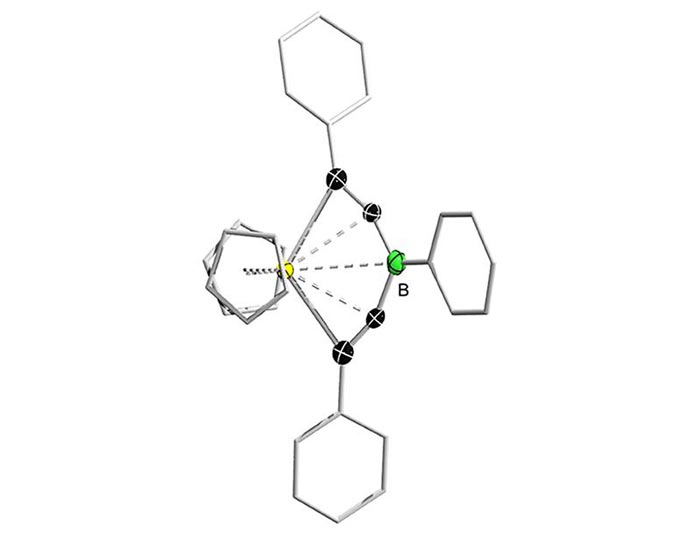Exploring New Catalysts and Photomaterials

Example of a bisalkynyl borane (B is the boron atom) coordinated as a ligand to a metal centre (yellow).
(c) Qing Ye / University of Würzburg
Chemistry professor Qing Ye wants to achieve fundamental innovations with boron-containing molecules. To this end, he has raised considerable funding, which also includes positions for PhD students.
The basis for a new generation of chemical catalysts may be laid at Julius-Maximilians-Universität Würzburg (JMU). Here, Professor Qing Ye is investigating the molecule class of bisalkynyl boranes. “They have been little studied so far compared to other boranes,” he says, “and I see great potential for fundamental innovations in them.”
Apparently, the German Research Foundation (DFG) also sees this potential: It has granted the chemistry professor 415,000 euros for a project to study bisalkynyl boranes. With the money, Ye can fill two doctoral positions for three years. He is currently looking for interested PhD students.
Many years of Würzburg experience

Photo: Christoph Weiss / University of Würzburg
Qing Ye was appointed Professor of Inorganic Molecular Chemistry at JMU at the beginning of 2022. He already knew Würzburg very well, having spent much of his academic career here.
In 2004, he came to the University of Würzburg from his home country China as a chemistry student. He obtained his diploma here, he did his doctorate here with Professor Holger Braunschweig and he did research here as a postdoc.
Qing Ye spent the year 2015 at the University of California at Berkeley on a DFG fellowship. He then came back to Würzburg with a DFG return fellowship. In 2017, he accepted a professorship at the Southern University of Science and Technology in Shenzhen (China). He researched and taught there for five years, then came back to JMU again.
Ligands for chemical catalysts
What exactly is it about the bisalkynyl boranes that the professor sees so much potential in?
The boron-containing molecules are suitable as components for catalysts. Most people first think of exhaust gas purification in cars. Chemists, on the other hand, understand catalysts as complex molecular structures that facilitate chemical reactions or even make them possible in the first place. The development of catalysts that contribute to making production in the chemical and pharmaceutical industry more sustainable is therefore highly desirable.
Catalysts made of metal complexes and so-called ligands – these are small molecules that surround the metal atom – are often found in catalysis because they show high activity and selectivity. Qing Ye’s team synthesises various bisalkynyl boranes and tests them for their suitability as ligands. To do this, the team is testing different metal-ligand combinations and then analysing their properties.
“Titanium and zirconium are often used as metal centres in catalysts. Together with them, the bisalkynyl boranes work well,” says Professor Ye. The resulting complexes are stable, but also reactive enough to be considered for catalysis, he says.
Possible applications in optoelectronics
During his research, the chemist came across another interesting property of bisalkynyl boranes. “Some of them rearrange themselves after you connect them to a metal centre. We can detach them from the metal again and get novel structures with completely new properties in a relatively simple way.”
Some of these new boron-containing molecules fluoresce strongly, and this makes them interesting for applications in optoelectronics. “If you wanted to synthesise these structures, which have virtually come into being on their own, through traditional methods, it would not be very easy,” says the professor.
Another DFG project underway
Qing Ye has recently been granted another research project by the DFG, endowed with 240,000 euros. For this project, he can fill one doctoral position. It revolves around the synthesis and investigation of benzoborirenes. “This is a class of ring-shaped molecules with exceptionally high ring tension and a unique electron structure,” he explains.
Wissenschaftliche Ansprechpartner:
Prof. Dr. Qing Ye, Institute of Inorganic Chemistry, University of Würzburg, T +49 931 31-88611, qing.ye@uni-wuerzburg.de
Weitere Informationen:
https://www.chemie.uni-wuerzburg.de/inorgchem/forschungsgruppen/prof-dr-qing-ye/… Website Prof Qing Ye
Media Contact
All latest news from the category: Life Sciences and Chemistry
Articles and reports from the Life Sciences and chemistry area deal with applied and basic research into modern biology, chemistry and human medicine.
Valuable information can be found on a range of life sciences fields including bacteriology, biochemistry, bionics, bioinformatics, biophysics, biotechnology, genetics, geobotany, human biology, marine biology, microbiology, molecular biology, cellular biology, zoology, bioinorganic chemistry, microchemistry and environmental chemistry.
Newest articles

Properties of new materials for microchips
… can now be measured well. Reseachers of Delft University of Technology demonstrated measuring performance properties of ultrathin silicon membranes. Making ever smaller and more powerful chips requires new ultrathin…

Floating solar’s potential
… to support sustainable development by addressing climate, water, and energy goals holistically. A new study published this week in Nature Energy raises the potential for floating solar photovoltaics (FPV)…

Skyrmions move at record speeds
… a step towards the computing of the future. An international research team led by scientists from the CNRS1 has discovered that the magnetic nanobubbles2 known as skyrmions can be…





















